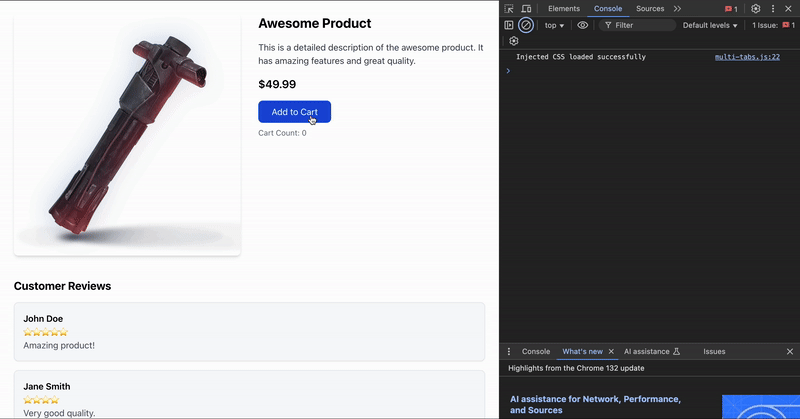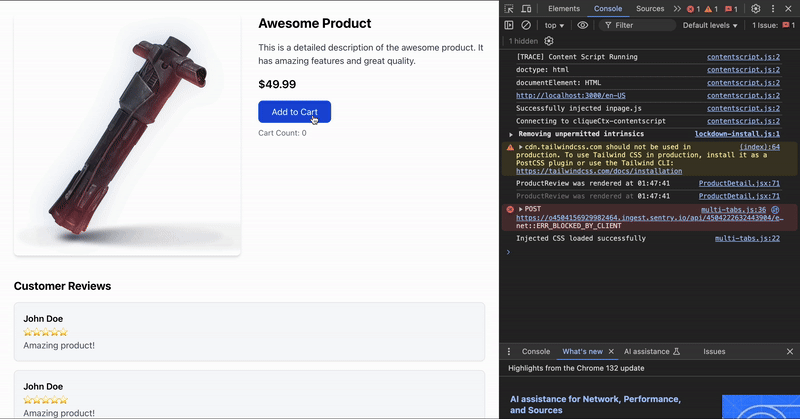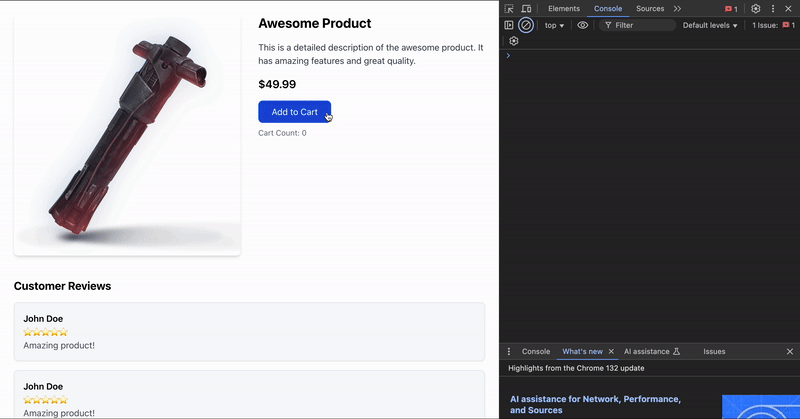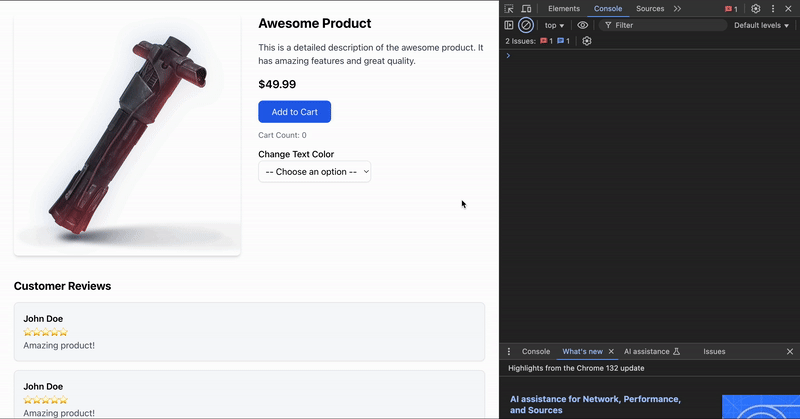
React.memo explained: When to use it (and when not to)
React.memo explained: When to use it (and when not to) 관련

React components re-render whenever their parent updates, even if their props remain unchanged. This can cause performance issues, especially with large datasets or complex UI updates. React.memo helps optimize performance by memoizing components and preventing unnecessary re-renders. But does it always work?

In this guide, you’ll learn when to use React.memo — and when to avoid it.
TL;DR
*What is React.memo, and how does it work?
React.memo is a higher-order component (HOC) that memoizes functional components, preventing them from re-rendering unless their props change.
*Does React.memo improve performance?
Yes, it helps optimize performance by skipping unnecessary re-renders. However, it should be used only when performance issues arise, as unnecessary memoization can add complexity.
*When should you use React.memo?
Use React.memo when:
- A component re-renders frequently with the same props
- The component is expensive to render (e.g., large lists, complex UI elements)
- It receives props that rarely change
Why is my React.memo component still re-rendering?
Even with React.memo, a component will still re-render if:
- Its props reference changes (e.g., new function or object instances are created every render)
- It depends on context or state that updates frequently
- It contains
useEffector subscriptions that trigger updates
React.memo vs. useMemovs. useCallback — what’s the difference?
React.memoprevents re-renders for entire components when props haven’t changeduseMemomemoizes computed values to avoid expensive recalculationsuseCallbackmemoizes functions to prevent unnecessary re-creation
What is memoization?
Memoization is a performance optimization technique that caches the result of a function and returns the cached value for subsequent calls with the same inputs.
In React, memoization helps prevent unnecessary re-renders of components handling large datasets, resource-heavy operations, or expensive calculations.
What is React.memo?
React.memo is a React API that caches functional components on the first render and returns the cached component as long as the props remain unchanged. If the props change, the component re-renders.
Under the hood, React.memo uses Object.is for a shallow comparison of the previous and new props. If they are identical, the cached version is returned; otherwise, the component re-renders.
Skipping unnecessary re-rendering
Let’s consider an ecommerce case study where a product detail page displays reviews (a review component) for each product. The review component may re-render when unrelated parts of the product page update. This happens because, by default, React re-renders a child component whenever the parent component state changes.
Create a ProductDetailPage.jsx component in your React project and add the following:
import React, { useState } from "react";
const ProductDetailPage = () => {
const [cartCount, setCartCount] = useState(0);
const handleAddToCart = () => {
setCartCount(cartCount + 1);
alert("Product added to cart!");
};
return (
<div className="max-w-4xl mx-auto p-6">
{/* Product Section */}
<div className="grid grid-cols-1 md:grid-cols-2 gap-8">
{/* Product Image */}
<div>
<img
src="https://res.cloudinary.com/muhammederdem/image/upload/q_60/v1536405217/starwars/item-2.webp"
alt="Product"
className="w-full h-auto rounded-lg shadow-md"
/>
</div>
{/* Product Details */}
<div>
<h1 className="text-2xl font-bold mb-4">Awesome Product</h1>
<p className="text-gray-700 mb-4">
This is a detailed description of the awesome product. It has
amazing features and great quality.
</p>
<p className="text-xl font-semibold mb-4">$49.99</p>
<button
onClick={handleAddToCart}
className="bg-blue-600 text-white px-6 py-2 rounded-lg hover:bg-blue-700 transition"
>
Add to Cart
</button>
<p className="mt-2 text-sm text-gray-500">Cart Count: {cartCount}</p>
</div>
</div>
{/* Review Section */}
<ProductReview />
</div>
);
};
const ProductReview = () => {
const reviews = [
{ id: 1, author: "John Doe", rating: 5, comment: "Amazing product!" },
{ id: 2, author: "Jane Smith", rating: 4, comment: "Very good quality." },
{
id: 3,
author: "Alex Johnson",
rating: 3,
comment: "It's decent for the price.",
},
];
console.log("ProductReview was rendered at", new Date().toLocaleTimeString());
return (
<div className="mt-10">
<h2 className="text-xl font-bold mb-4">Customer Reviews</h2>
<div className="space-y-4">
{reviews.map((review) => (
<div className="p-4 border rounded-lg bg-gray-50 shadow-sm">
<p className="font-semibold">{review.author}</p>
<p className="text-yellow-500">{"⭐".repeat(review.rating)}</p>
<p className="text-gray-600">{review.comment}</p>
</div>
))}
</div>
</div>
);
};
export default ProductDetailPage;
The ProductDetailPage component is the parent component of the ProductReview component. It maintains a cartCount state to track how many times the user clicks the “Add to Cart” button, updating the count and displaying a confirmation alert. The ProductReview component renders a list of customer reviews and logs the render time to the console for tracking performance.
Running the project should result in the following:

Notice how the ProductReview component re-renders each time the user adds the product to the cart. This re-render is unnecessary because updating the cart does not impact the customer reviews.
Since the number of reviews in the ProductReview component is small, the performance impact is negligible. However, let’s examine the effect when the component handles thousands of reviews. Update the reviews array as follows:
const reviews = Array.from({ length: 10000 }, () => ({ id: Math.random(), author: "John Doe", rating: 5, comment: "Amazing product!" }));

At this point, adding the product to the cart introduces a noticeable lag. If you click the Add to Cart button multiple times in quick succession, the entire page may freeze. This happens because React re-renders all 10,000 reviews each time the state updates, significantly slowing down the application.
Clearly, excessive re-renders negatively impact performance. We can optimize this behavior by using React.memo to prevent unnecessary re-renders of the ProductReview component.
Applying React.memo
To optimize performance, wrap the ProductReview component with React.memo as follows:
import React, { memo } from "react";
const ProductReview = memo(() => {
const reviews = Array.from({ length: 10000 }, () => ({ id: Math.random(), author: "John Doe", rating: 5, comment: "Amazing product!" }));
console.log("ProductReview was rendered at", new Date().toLocaleTimeString());
return (
<div className="mt-10">
<h2 className="text-xl font-bold mb-4">Customer Reviews</h2>
<div className="space-y-4">
{reviews.map((review) => (
<div key={review.id} className="p-4 border rounded-lg bg-gray-50 shadow-sm">
<p className="font-semibold">{review.author}</p>
<p className="text-yellow-500">{"⭐".repeat(review.rating)}</p>
<p className="text-gray-600">{review.comment}</p>
</div>
))}
</div>
</div>
);
});
export default ProductDetailPage;
With this modification, ProductReview will only re-render when its props change, effectively preventing unnecessary re-renders when updating the cart. This simple adjustment significantly improves the application’s responsiveness and ensures better performance:

Optimizing re-renders when props change
React.memo can be used to optimize re-renders by ensuring a component updates only when its props change. Let’s demonstrate this by adding a feature that allows users to change the text color of both the product name and the review header.
Updating ProductDetailPage
Modify the ProductDetailPage component to include a dropdown that allows users to select a text color:
const ProductDetailPage = () => {
const [cartCount, setCartCount] = useState(0);
const [color, setColor] = useState("");
const handleChange = (event) => {
setColor(event.target.value);
};
const handleAddToCart = () => {
setCartCount(cartCount + 1);
alert("Product added to cart!");
};
return (
<div className="max-w-4xl mx-auto p-6">
{/* Product Section */}
<div className="grid grid-cols-1 md:grid-cols-2 gap-8">
{/* Product Image */}
{/* Product Details */}
<div>
<h1 className={`text-2xl font-bold mb-4 ${color}`}>
Awesome Product
</h1>
<p className="text-gray-700 mb-4">
This is a detailed description of the awesome product. It has
amazing features and great quality.
</p>
<p className="text-xl font-semibold mb-4">$49.99</p>
<button
onClick={handleAddToCart}
className="bg-blue-600 text-white px-6 py-2 rounded-lg hover:bg-blue-700 transition"
>
Add to Cart
</button>
<p className="my-3 text-sm text-gray-500">Cart Count: {cartCount}</p>
<div>
<p className="font-medium">Change Text Color</p>
<select
value={color}
onChange={handleChange}
className="border rounded-lg p-2 bg-white shadow-sm focus:outline-none focus:ring-2 focus:ring-blue-500"
>
<option value="" disabled>
-- Choose an option --
</option>
<option value="text-blue-700">Blue</option>
<option value="text-red-700">Red</option>
<option value="text-green-700">Green</option>
</select>
</div>
</div>
</div>
{/* Review Section */}
<ProductReview color={color} />
</div>
);
};
Here, we’ve added a dropdown select to choose different text colors and pass the color prop to the ProductReview component.
To access the color prop, make the following changes to the ProductReview component:
const ProductReview = memo(({color}) => {
const reviews = Array.from({ length: 10000 }, () => ({ id: Math.random(), author: "John Doe", rating: 5, comment: "Amazing product!" }));
console.log("ProductReview was rendered at", new Date().toLocaleTimeString());
return (
<div className="mt-10">
<h2 className={`text-xl font-bold mb-4 ${color}`}>Customer Reviews</h2>
<div className="space-y-4">
{reviews.map((review) => (
<div key={review.id} className="p-4 border rounded-lg bg-gray-50 shadow-sm">
<p className="font-semibold">{review.author}</p>
<p className="text-yellow-500">{"⭐".repeat(review.rating)}</p>
<p className="text-gray-600">{review.comment}</p>
</div>
))}
</div>
</div>
);
});
With these modifications:
- The
ProductReviewcomponent will re-render only when thecolorprop changes - Changing the cart count will no longer trigger a re-render of the
ProductReviewcomponent
This ensures better performance and prevents unnecessary renders, improving the responsiveness of the application:

React.memo ExampleSkipping expensive recalculations with useMemo
Did you notice the lag in the UI after choosing a text color? This happens because when the color prop changes, thousands of reviews are regenerated using Array.from() and then re-rendered. To fix this issue, we’ll use the useMemo hook to cache the result of the reviews computation.
Optimizing ProductReview with useMemo
const ProductReview = memo(({ color }) => {
const reviews = useMemo(() =>
Array.from({ length: 10000 }, () => ({
id: Math.random(),
author: "John Doe",
rating: 5,
comment: "Amazing product!"
})), []);
console.log("ProductReview was rendered at", new Date().toLocaleTimeString());
return (
<div className="mt-10">
<h2 className={`text-xl font-bold mb-4 ${color}`}>Customer Reviews</h2>
<div className="space-y-4">
{reviews.map((review) => (
<div key={review.id} className="p-4 border rounded-lg bg-gray-50 shadow-sm">
<p className="font-semibold">{review.author}</p>
<p className="text-yellow-500">{"⭐".repeat(review.rating)}</p>
<p className="text-gray-600">{review.comment}</p>
</div>
))}
</div>
</div>
);
});
With this modification, the reviews array is computed only on the first render, significantly improving performance.
Adding dependencies to useMemo
const [size, setSize] = useState(10);
const reviews = useMemo(() =>
Array.from({ length: size }, () => ({
id: Math.random(),
author: "John Doe",
rating: 5,
comment: "Amazing product!"
})), [size]);
Now, useMemo will recompute reviews each time the size dependency changes.
Memoizing function props
By default, function definitions in React components change on every re-render. If a function is passed as a prop to a memoized component, memoization will not work unless the function itself is memoized.
Example without memoization
export default function Cart({ orderId }) {
function handleCheckout(orderDetails) {
post('/checkout/' + orderId + '/buy', {
orderDetails
});
}
return <Checkout onSubmit={handleCheckout} />;
}
In this case, handleCheckout is re-created every render, causing unnecessary re-renders in Checkout.
Using useMemo
export default function Cart({ orderId }) {
const handleCheckout = useMemo(() => (orderDetails) => {
post('/checkout/' + orderId + '/buy', {
orderDetails
});
}, [orderId]);
return <Checkout onSubmit={handleCheckout} />;
}
A cleaner approach is to use useCallback.
Using useCallback
const handleCheckout = useCallback(
(orderDetails) => {
post('/checkout/' + orderId + '/buy', {
orderDetails
});
}, [orderId]);
Memoizing array and object props
Similar to functions, array and object definitions change on every re-render. If an object or array is passed as props to a memoized component, memoization will not work unless they are also memoized.
Memoizing an object
const paymentOptions = useMemo(() => ({
paymentMode: 'credit-card',
amount: amount
}), [amount]);
Memoizing an array
const cardTypes = useMemo(() => ['credit-card', 'debit-card'], []);
By memoizing objects and arrays, we ensure that components relying on them do not re-render unnecessarily, leading to better performance and efficiency in React applications.
Just like the function definition, every array and object definition in a React component changes on every rerender and if an object or array is passed as props to a memoized component, memoization will not work.
Here is how to memoize an object:
const paymentOptions = useMemo(() => {
return {
paymentMode: 'credit-card',
amount: amount
};
}, [amount]);
Here is how to memoize an array:
const cardTypes = useMemo(() => {
return ['credit-card', 'debit-card'];
}, []);
Optimizing component re-rendering when context changes
By default, React re-renders components when there’s a change in context. This also applies to memoized components, as demonstrated in the following code snippet:
import React, { createContext, useContext, useState, memo } from 'react';
const UserContext = createContext();
export const App = () => {
const [user, setUser] = useState({ name: 'John', age: 30 });
return (
<UserContext.Provider value={user}>
<UserName />
<p style={{ color: 'white' }}>Age: {user.age}</p>
<button onClick={() => setUser({ ...user, age: user.age + 1 })}>
Increment Age
</button>
</UserContext.Provider>
);
};
const UserName = memo(() => {
const { name } = useContext(UserContext);
console.log('UserName rendered');
return <div style={{ color: 'white' }}>User Name: {name}</div>;
});
Each time the user’s age value changes, the memoized UserName component still re-renders, even though the name value remains unchanged. To prevent this, pass only the required part of the context as a prop to the memoized component.
import React, { createContext, useContext, useState, memo } from 'react';
const UserContext = createContext();
export const App = () => {
const [user, setUser] = useState({ name: 'John', age: 30 });
return (
<UserContext.Provider value={user}>
<UserDisplay />
<p style={{ color: 'white' }}>Age: {user.age}</p>
<button onClick={() => setUser({ ...user, age: user.age + 1 })}>
Increment Age
</button>
</UserContext.Provider>
);
};
const UserDisplay = () => {
const { name } = useContext(UserContext);
return <UserName name={name} />;
};
const UserName = memo(({ name }) => {
console.log('UserName rendered');
return <div style={{ color: 'white' }}>User Name: {name}</div>;
});
When you should avoid memoization
Avoid using memoization:
- If there is no noticeable lag in UI interactions.
- When using values inside
useEffect - To wrap JSX nodes
Memoizing values used inside useEffect is unnecessary. Instead, move the value inside the effect:
useEffect(() => {
const options = {
serverUrl: 'https://localhost:1234',
roomId: roomId
};
const connection = createConnection(options);
connection.connect();
return () => connection.disconnect();
}, [roomId]);
Wrapping JSX nodes in useMemo prevents conditional rendering:
const children = useMemo(() => <ProductList items={products} />, [products]);
Using PureComponent in class components
For class-based components, React.memo, useMemo, and useCallback will not work. Instead, use PureComponent, which re-renders only when its props change:
class PureComponentExample extends React.PureComponent {
render() {
console.log('Pure Component rendered');
return <div>{this.props.value}</div>;
}
}
Potential issues with PureComponent
If you pass objects or arrays that mutate without changing their reference, PureComponent may not detect changes:
import React, { PureComponent } from 'react';
class ChildComponent extends PureComponent {
render() {
console.log('ChildComponent rendered');
return <div>Message: {this.props.data.message}</div>;
}
}
export default class App extends React.Component {
state = {
data: { message: 'Hello' }
};
updateMessage = () => {
const { data } = this.state;
data.message = 'Hello, World!'; // Mutating the state object
this.setState({ data }); // Setting the same object reference
};
render() {
return (
<div>
<ChildComponent data={this.state.data} />
<button onClick={this.updateMessage}>Update Message</button>
</div>
);
}
}
Because this.setState({ data }) does not create a new object reference, PureComponent cannot detect the update, and ChildComponent will not re-render. To fix this, always create a new reference:
updateMessage = () => {
this.setState({ data: { ...this.state.data, message: 'Hello, World!' } });
};
Comparing React.memo to useMemo, useCallback, and PureComponent
The following table will help you know when to use React.memo, useMemo, useCallback.
| Feature | React.memo | useMemo | useCallback | PureComponent |
|---|---|---|---|---|
| Usage | Prevent component re-renders | Avoid recalculating values | Avoid recreating functions | Avoid re-rendering in class components |
| Scope | Component-level | Value-level | Function-level | Class components only |
Conclusion
In this article, we explored how React.memo can improve app performance by skipping unnecessary re-renders. We covered real-world use cases, best practices, and when to avoid memoization. Additionally, we compared React.memo with useMemo, useCallback, and PureComponent to understand their specific use cases.
By applying these techniques wisely, you can significantly enhance the efficiency of your React applications!